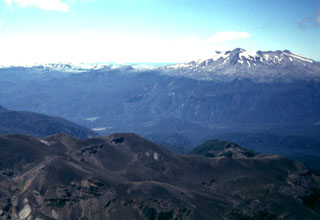Report on Puyehue-Cordon Caulle (Chile) — 26 October-1 November 2011
Smithsonian Institution / US Geological Survey
Weekly Volcanic Activity Report, 26 October-1 November 2011
Managing Editor: Sally Sennert.
Please cite this report as:
Global Volcanism Program, 2011. Report on Puyehue-Cordon Caulle (Chile) (Sennert, S, ed.). Weekly Volcanic Activity Report, 26 October-1 November 2011. Smithsonian Institution and US Geological Survey.
Puyehue-Cordon Caulle
Chile
40.59°S, 72.117°W; summit elev. 2236 m
All times are local (unless otherwise noted)
Based on seismicity during 26 October-1 November, OVDAS-SERNAGEOMIN reported that the eruption from the Cordón Caulle rift zone, part of the Puyehue-Cordón Caulle volcanic complex, continued at a low level.
During 26-29 October white plumes observed with an area web camera rose 4.5-5 km above the crater. Satellite imagery showed a plume drifting 30 km SW and W on 26 October, and diffuse ash plumes drifting E during 27-28 October. Small incandescent explosions were observed at night during 28-29 October. A plume observed in satellite imagery drifted 180 km N and NW on 29 October, and ashfall was reported in Lonquimay.
On 30 October seismicity possibly indicated minor lava effusion. A mostly white plume rose 7.5 km above the crater and ash plumes observed in satellite imagery drifted 350 km NW and N. Ashfall was reported in Río Bueno (80 km WNW). Small incandescent explosions were observed at night during 30-31 October. A mostly white plume rose as high as 6.5 km above the crater on 31 October and ash plumes observed in satellite imagery drifted 270 km S and SSW. On 1 November satellite imagery showed an ash plume that drifted 300 km SE. The Alert Level remained at Red.
Geological Summary. The Puyehue-Cordón Caulle volcanic complex (PCCVC) is a large NW-SE-trending late-Pleistocene to Holocene basaltic-to-rhyolitic transverse volcanic chain SE of Lago Ranco. The 1799-m-high Pleistocene Cordillera Nevada caldera lies at the NW end, separated from Puyehue stratovolcano at the SE end by the Cordón Caulle fissure complex. The Pleistocene Mencheca volcano with Holocene flank cones lies NE of Puyehue. The basaltic-to-rhyolitic Puyehue volcano is the most geochemically diverse of the PCCVC. The flat-topped, 2236-m-high volcano was constructed above a 5-km-wide caldera and is capped by a 2.4-km-wide Holocene summit caldera. Lava flows and domes of mostly rhyolitic composition are found on the E flank. Historical eruptions originally attributed to Puyehue, including major eruptions in 1921-22 and 1960, are now known to be from the Cordón Caulle rift zone. The Cordón Caulle geothermal area, occupying a 6 x 13 km wide volcano-tectonic depression, is the largest active geothermal area of the southern Andes volcanic zone.
Source: Servicio Nacional de Geología y Minería (SERNAGEOMIN)

